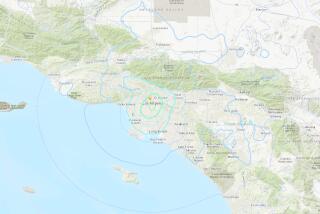Are you prepared for natural disaster? 4 in 5 Angelenos are not
The swarm of earthquakes in Imperial County this week serves as an unexpected prelude to National Preparedness Month, a.k.a. September. Southern California is home to 13 of the 16 catastrophic hazards that the U.S. government recognizes, including temblors, fires and severe weather, but most Angelenos are far from ready.
Just 20% of us have made plans or assembled kits that would help navigate a disaster, according to Chris Ipsen, public information officer for Los Angelesâ Emergency Management Department, despite almost constant news stories about fires, floods and other events.
Where to start? The city maintains the ReadyLA website, which offers extensive information on how to assemble an emergency supply kit, how to develop a household disaster plan and how (and when) to shut off utilities, among other things.
Residents might also want to sign up for Alert LA County, an emergency notification service used by the countyâs emergency operations center to text, email or call with updates about critical situations associated with affected street addresses. Land-line phones are automatically included in the system; households with cellphones need to register online.
âWhatâs happening now with Hurricane Isaac and the temblors weâve been having are reminders that we live in an area thatâs prone,â Ipsen said. âWith the economic downturn, a lot of people say, âI canât afford to do that.â If youâve ever been to a 99-cent store, itâs an excellent location to put together a very good kit for little money. Itâs taking action that matters.â
Individuals shouldnât have just one emergency kit, Ipsen said. They should have three -- at home, at work and in their cars. Kits should be assembled to last a minimum of three days, and, optimally, two weeks.
Water is the most important item, followed by food and important documents such as insurance policies, bank account information, ID cards and photographs to help identify the missing. Cash in small denominations is recommended in case electricity is out and businesses are unable to process electronic payments; cash for payphones could be helpful if cellphone service is interrupted.
Ipsen also recommends a flashlight and sturdy shoes as must-haves to help navigate around debris because âthe biggest causes of injuries in a home or workplace is bookshelves, china cabinets and large mirrors that arenât properly secured.â
Because families are often separated in disasters, Ipsen suggested coordinating a plan that involves multiple forms of communication, including Skype, Facebook, Twitter and a real-world meeting place, such as a park.
âParks are easy to find. People know where they are. In general, there arenât any high-rise buildings and there arenât a lot of power lines,â Ipsen said. âItâs open space away from potential harm that might be another access point for resources.â
More to Read
Sign up for Essential California
The most important California stories and recommendations in your inbox every morning.
You may occasionally receive promotional content from the Los Angeles Times.










